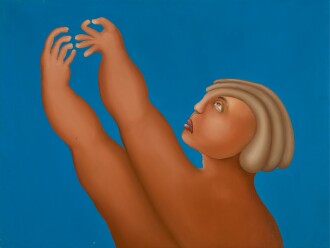Works by Manjit Bawa at Sotheby's
Manjit Bawa Biography
Manjit Bawa was born in Dhuri, Punjab in 1941.
His luminous works on canvas represent a unique exploration of color, form and space, drawing the viewer into an intimate experience of the artist's world. The artist's distinctive use of color was grounded in his formal training as a serigrapher and printer.
Bawa studied serigraphy at the London School of Printing, Essex and worked in London as a print maker from 1967 to 1971. Back in India, fellow artist Jagdish Swaminathan invited him to start a print making department in Bhatat Bhavan, Bhopal. Bawa enjoyed making serigraphs not only of his own works but also for his artist friends. For his own prints he experimented with shapes and stark backgrounds that later became a part of his iconography as a painter. The artist reinvented the free floating form, which later became figures, by incorporating his early study of the forms and colors of Rajput and Pahari miniature paintings. His subjects were often inspired by icons and myths which represent the dual polarities of the human and animal world; although they share the same environment they 'occupy separate mental universes'. Bawa's works question the dynamics of these relationships, how one communicates with the other.
A critical and transformative moment in Bawa’s career came almost a decade late, as “in the early 1980s, Bawa fulfilled an ambition he set for himself in reaction to art-school masters: he created his own figural form, distinct from the work of other artists. Drawing and plein-air sketching were central to this project” (Susan Bean, “Manjit Bawa,” Midnight to the Boom, p. 128).
For Bawa, the simplicity of line and form was always contrasted by the subtle graduation of color and the artist's use of chiaroscuro. His canvases are easily distinguished for their bright colors reflected in the rich Indian palette. Manjit Bawa's luminous paintings bear a unique exploration of form and space and draw the viewer into an intimate experience with the artist's world. His delicately drawn figures are imbued with a sense of vulnerability and ethereality that is further heightened by the striking color fields which seem to render the forms weightless.
Bawa fondly reminisces about his artistic choices and aptly says, 'Being a turbanned Sikh from an ordinary middle-class family was daunting enough but to strike out against the prevalent forces of Cubism and the iconic Klee was to really ask for big trouble and I was hauled up time and again with strict instructions to toe the line. But I remained true to my calling, naturally annoying authorities. Even then in those formative years I was haunted by the spectre of mediocrity. I was willing to accept any challenge, but on my own terms. I was obsessed with one driving need – to create my own painterly language.’ (M. Bawa, ‘I Cannot Live By Your Memories, Manjit Bawa in Conversation with Ina Puri’, Let’s Paint the Sky Red: Manjit Bawa, Vadehra Art Gallery, New Delhi, 2011, p. 47)












